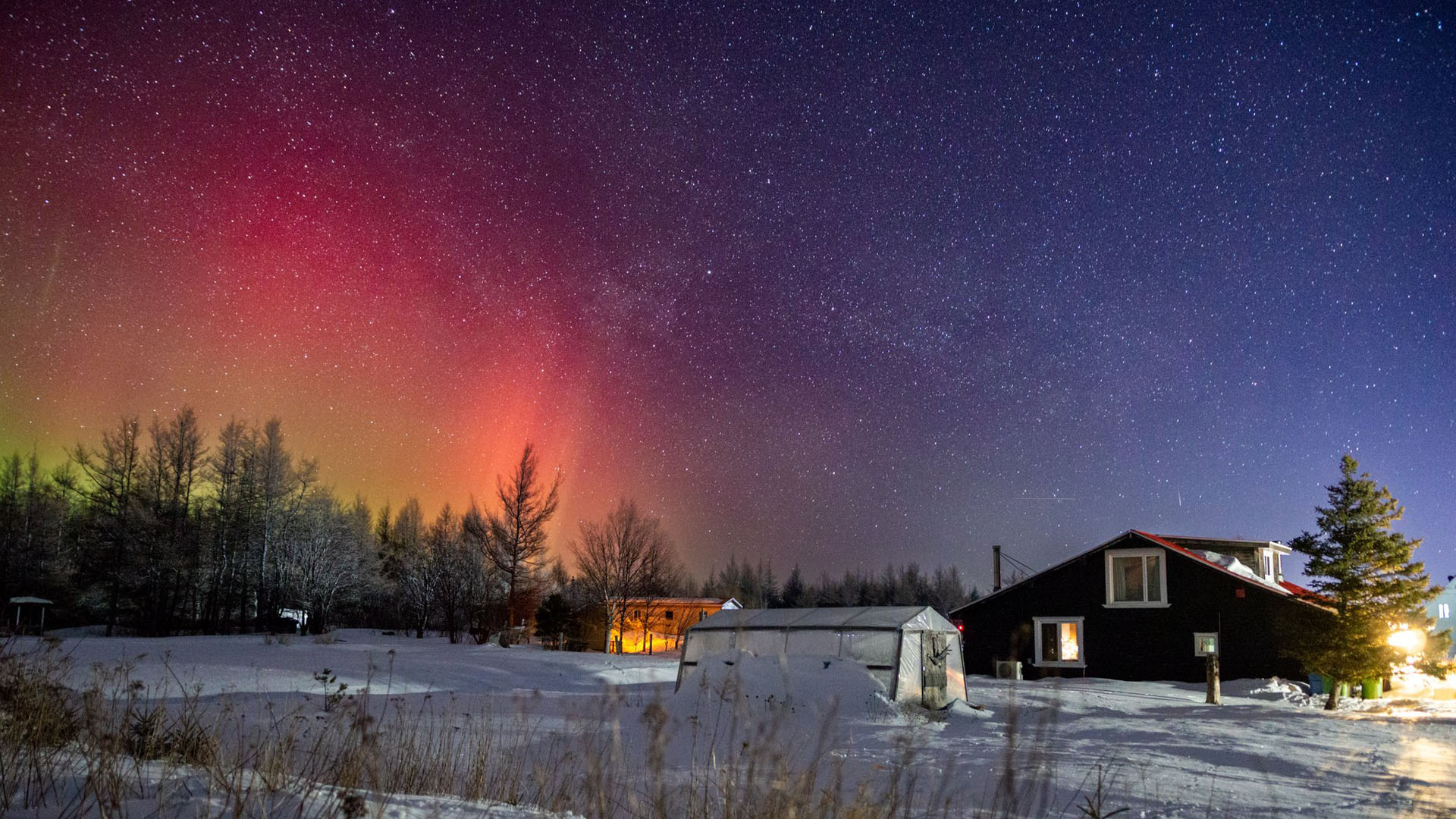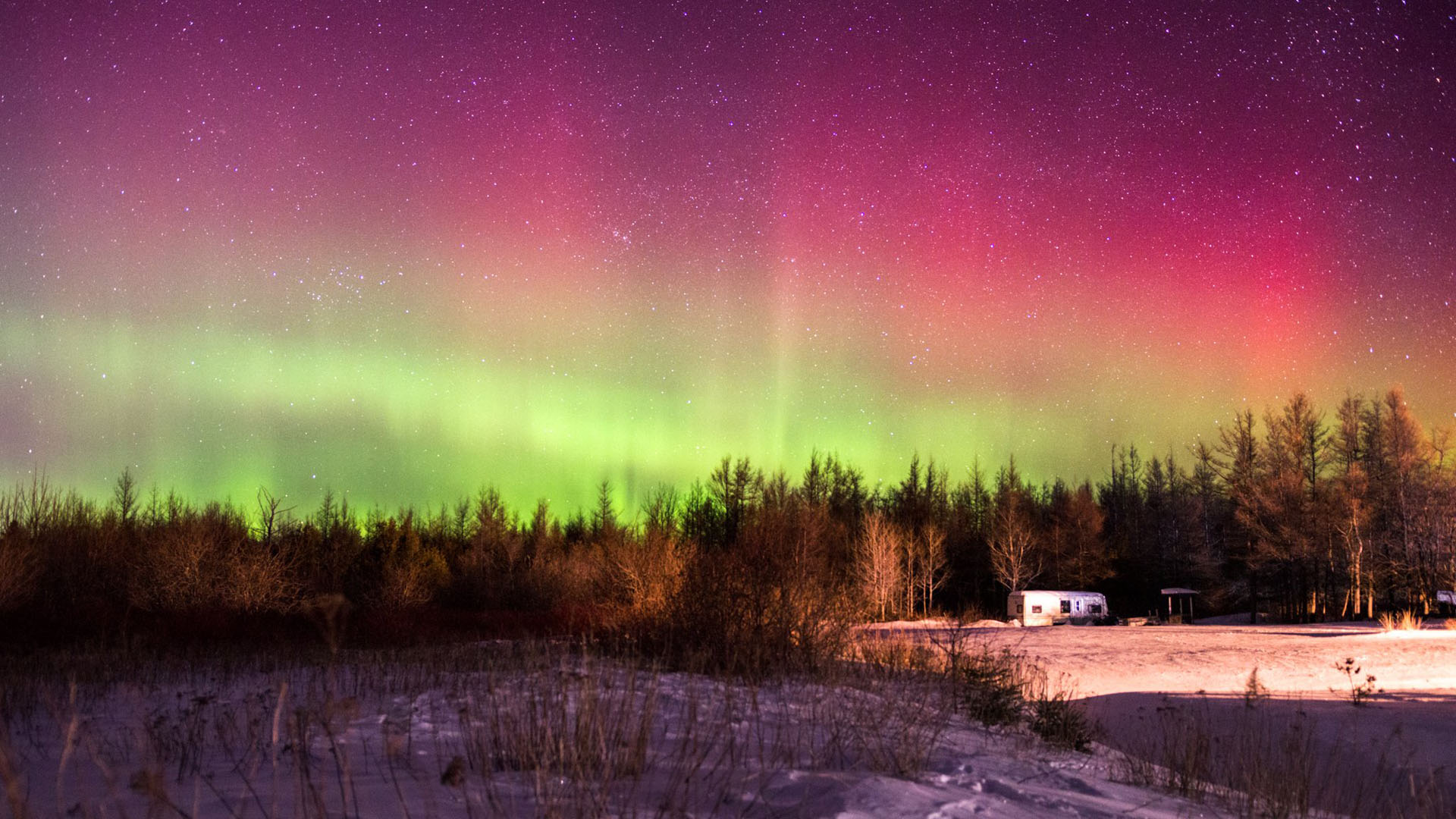Rare red auroras explode over northern US and Europe with more on the way (photos)
Geomagnetic storms caused by bursts of plasma arriving from the sun have delivered a night of aurora spectacle to skywatchers in Canada, northern U.S. and Europe.

A stream of solar plasma arrived at Earth last night (Feb. 16), supercharging the atmosphere with particles from the solar wind that triggered rare red aurora displays across vast portions of Canada, northern U.S. and Europe. And space weather forecasters promise that more is on its way.
Twitter has been virtually awash over the past days with skywatchers' images and accounts of spectacular aurora sightings. The latest wave of dancing polar lights has been especially striking, as it arrived in rare shades of red that require higher concentrations of solar wind particles to penetrate deeper into Earth's atmosphere.
Quebec, Canada-based aurora hunter Mike MacLellan was able to catch some out-of-this-world photographs of the horizon ablaze with bright neon-like green that turns into orange, red and purple higher up in the sky, and shared them with Space.com.
Similar red aurora sightings have been reported by photographers in Scotland and Norway.
"No words for last night's show over Kåfjorddalen, Norway," aurora chaser Adrien Mauduit, who tweets from the @NightLights_AM Twitter account, shared with a selection of images capturing fireworks-like explosion of purple and green above a snow-covered landscape.


One of Mauduit's pictures shows a butterfly-shaped glow of bright orange, pink and purple above a rocky mountain top.
Get the Space.com Newsletter
Breaking space news, the latest updates on rocket launches, skywatching events and more!
"Did someone say "red"? 😱 absolutely monstrous aurora minutes ago in Skibotn, Norway," Mauduit said in the tweet.
Wow!! The jaw dropping view this morning in Central Alberta!😱😱😍😍 #Teamtanner #aurora #northernlights @treetanner @mikesobel @ScottWx_TWN @weathernetwork pic.twitter.com/0oTcXtIO8NFebruary 17, 2023
Dan Tanner from Alberta, Canada, shared a photo capturing a wintery sunrise supercharged by green and purple glow illuminating the dawn sky.
"Wow!! The jaw dropping view this morning in Central Alberta!," Tanner said in a tweet.
Amateur photographer and Twitter user Cogie_s shared a batch of breathtaking images of green and red auroras in Scotland.
Over looking East Langwell, Rogart, Sutherland, Scotland 15/16th Feb. (14mm) As bright as #Norway, but side-on view 😎#aurora @chunder10 @TamithaSkov @SimonOKing @BBCHighlands @StormchaserUKEU pic.twitter.com/XeVQIjfLftFebruary 16, 2023
The aurora overload is expected to continue and possibly get even more intense as a coronal mass ejection (CME), a burst of plasma from the sun's upper atmosphere that erupted from the sun Feb. 15 is arriving at Earth today.
Aurora sightings as far south as the north of England and the U.S. can be expected. Geomagnetic storms are expected to carry on until at least Feb. 19, so if you have an opportunity, head north for the weekend to make the most of it.
Follow Tereza Pultarova on Twitter @TerezaPultarova. Follow us on Twitter @Spacedotcom and on Facebook.
Join our Space Forums to keep talking space on the latest missions, night sky and more! And if you have a news tip, correction or comment, let us know at: community@space.com.

Tereza is a London-based science and technology journalist, aspiring fiction writer and amateur gymnast. Originally from Prague, the Czech Republic, she spent the first seven years of her career working as a reporter, script-writer and presenter for various TV programmes of the Czech Public Service Television. She later took a career break to pursue further education and added a Master's in Science from the International Space University, France, to her Bachelor's in Journalism and Master's in Cultural Anthropology from Prague's Charles University. She worked as a reporter at the Engineering and Technology magazine, freelanced for a range of publications including Live Science, Space.com, Professional Engineering, Via Satellite and Space News and served as a maternity cover science editor at the European Space Agency.
-
billslugg I witnessed a red aurora here in Albany, GA in March 1989 during the great solar storm. We are but 30 degrees north of the equator.Reply









